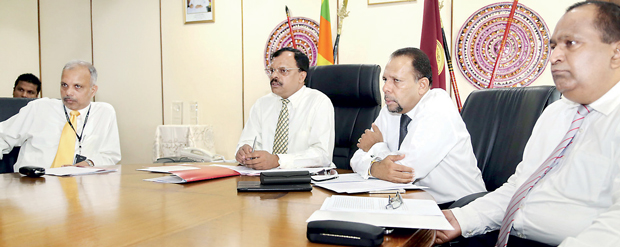Reply To:
Name - Reply Comment

From left: N. Vasantha Kumar, Piyadasa Kudabalage, Jehan P. Amaratunga and People’s Bank Head of Marketing and Public Affairs Deepal Abeysekara
Pic by Pradeep Dilrukshana
.jpg)
The second largest state sector bank, People’s Bank has cut its pawning exposure by as much as Rs.120 billion from January 2013 through September 30, 2014, but said the bank is actively encouraging the loans against the precious metal, which is losing its glory days, according to a senior official of the bank.
End of December 2012, People’s Bank – the largest gold-backed lender in the country – had a gold-backed lending portfolio of Rs.250.8 billion, which accounted for 33.9 percent of its total advances.
Bank of Ceylon, being the second player in this market, had only Rs.142.0 billion – 20 percent of total advances during the same period.
According to People’s Bank Director Piyadasa Kudabalage, the bank reduced the exposure to Rs.220 by end-December 2013 and further to Rs.130 billion by September 30, 2014.
.jpg)
Meanwhile, People’s Bank Director Jehan P. Amaratunga said the bank minimized this exposure through selling a major part of the articles at auctions and the rest by writing off against the profits from the heavy provisions made.
“We took a major hit last year and our profits suffered heavily but we are coming out of this crisis this year,” Amaratunga said.
Sri Lankan banking sector last year made huge provisioning against pawning loans as the world gold prices plunged and made significant write-offs against profits when the borrowers defaulted as the price of the metal worth less than the advance they already had.
However, the bank doesn’t seem to be less interested in giving advances against the gold despite paying a heavy price for significantly higher loan-to-value ratios.
“We are encouraging (pawning loans) within the set parameters of the bank but we are not discouraging,” Amaratunga added.
But the global gold prices are far from their recovery after the prices fell from a high of US $ 1,700 per ounce to US $ 1,239 per ounce at the COMEX futures exchange for December delivery and the hopes remains subdued with the dollar being strengthened with the United States economy on a recovery mode.
However, at the height of the gold bubble bursting in 2013, the bank’s Deputy General Manager Retail Banking G.P.R. Jayasinghe said the bank no longer encourages such loans in anticipation of a possible bubble.
“In fact, anticipating this, we have brought down our pawning advances to around 35 percent (from the total advances) and we are daily monitoring the situation as a control measure. We no more encourage gold-backed loans as we did before,” she said then. Meanwhile, People’s Bank CEO N. Vasantha Kumar said during the first six months, the bank’s loan book stood static but saw a 1.0 percent rise in the credit extended to the private sector so far during the second half of the year.
When applied the 2013 industry credit growth of 7.5 percent and Kumar’s claim of 1.0 percent credit growth for the first nine months, still People’s Bank has probably the largest exposure to gold-backed loans in the post-crisis period, which amounts to 16.23 percent of its total advances.
The calculations are based on the Rs.794 billion loan book as of end-December 2012.
Nevertheless, the bank can always reverse the losses (impairment reversal) charged against the profit when the gold prices gain in the world market, as certain banks have done but will only be an accounting entry as it is unrealized.
Meanwhile, Kudabalage said that the bank would most likely cross the Rs.1.0 trillion asset base by end-2014, becoming the second such bank to do so. As of end-September 2014, the bank’s total asset base stood at Rs.950 billion.
Bank of Ceylon has an asset base in excess of Rs.1.25 trillion.
The Central Bank under its banking and financial sector consolidation framework wants to create five banks with a Rs.1.0 trillion asset base and bring down the number of non-bank finance institutions (NBFIs) to 20 from the current 58.
Hence, Kudabalage, who is also the Managing Director of the state-owned Sri Lanka Insurance Corporation, said they need not absorb any smaller bank or NBFI as they already have financial sector subsidiaries and the Central bank had not even made a request to that effect.
Further asked if the bank might require to seek funding support from its only shareholder the National Treasury in view of the increased capital requirements under the expected BASEL III accord, he said they would expect to capitalize the profits so that the need would not arise for fresh capital infusion to meet new regulatory requirements.
Kudabalage further said the bank had posted a profit before tax of Rs.12.0 billion and a profit after tax of Rs.9.0 billion during the first nine months of 2014.
According to the bank’s officials, currently the bank’s Tier I and Tier II capital adequacy ratios stands at 8.0 percent and 14.0 percent, respectively, well above the regulatory minimums of 5.0 and 10.0 percent.